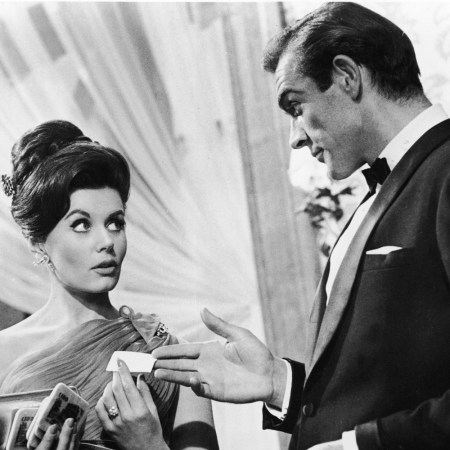If you’ve encountered any of James Bond’s adventures over the years, you’re already familiar with the basics: a license to kill, a car full of gadgets and a penchant for martinis. But let’s not forget some of the other elements of the James Bond mythos, like the Vietnam War-era origin story or the young relative getting into international misadventures of his own.
Right about here, your mind is probably doing a perfect needle-scratch, and that’s understandable. James Bond’s origin story was never filmed, and the adventures of, er, James Bond, Jr., aired on a short-lived animated series. But they’re only the tip of the iceberg — or, if you prefer, the villain’s base disguised as an iceberg — when it comes to James Bond’s less famous adventures.
Thankfully, a new book offers a deep dive into the permutations of 007 over the years, and, along the way, will likely make you wish Timothy Dalton had gotten another crack at the character. The book in question is Mark Edlitz’s The Lost Adventures of James Bond, and it’s the sort of book that even experts on the character might learn something from.
It’s not Edlitz’s first book on Bond — that would be The Many Lives of James Bond: How the Creators of 007 Have Decoded the Superspy. In his new book, Edlitz offers a fascinating look at how different creators have interpreted the character of 007, and what audiences would have seen in a number of unmade Bond films.

The Lost Adventures of James Bond abounds with summaries of unmade Bond films, including several from when both Timothy Dalton and Pierce Brosnan played the character. Besides the behind-the-scenes look at the Bond films in general, Edlitz also gives a sense of the sheer amount of work that went into action films of the era — including multiple treatments for wildly different films.
“Finding unmade Bond scripts and treatments can be difficult. Tracking down hard-to-find artists is often time-consuming. But the hunt is part of the fun,” Edlitz tells InsideHook. “The reward is discovering new material and then sharing it with other Bond fans.”
He cites an interview with Alfonse Ruggiero, co-writer of one version of what would have been Timothy Dalton’s third outing as Bond, as particularly challenging. “It took a while to get to him and even when I did, it took even longer to arrange the interview,” Edlitz recalls. “It was such a lengthy process to get him to talk that when he answered the phone to begin the interview, Ruggiero joked, ‘Are you surprised I picked up?’”
“The entire process took years. But the wait was worth it,” he adds. “Ruggiero was generous with his time and insightful about the writing process and the plans for Dalton’s unmade third film.”
A particularly fascinating segment in The Lost Adventures of James Bond involves a planned origin story for Bond, to be set in the early 1970s. “The origin story charts Bond’s course from a callow and aimless young man who is squandering his life, to his recoupment by M. to the secret service, to being paired with a senior agent, to eventually earning his Double-O status,” Edlitz recalls. “Richard Maibaum and Michael G. Wilson did a great job with the story.”
“However, Albert Broccoli determined that the audience wanted to see 007 at the height of his powers,” he continues. “So Maibaum and Wilson’s treatment featuring a younger James Bond was set aside.” Edlitz points out that elements of that earlier arc can be seen in Casino Royale — what he dubbed “an ingenious solution.”
That begs a question — in this era of reboots, prequels and origin stories, does James Bond need an origin story? “It’s important for Bond to retain a little mystery,” Edlitz says. “It’s often more fun for fans to speculate on Bond’s past.”
And — the more serialized approach of the Daniel Craig films aside — that’s what makes the character work, as far as Edlitz is concerned. “James Bond is timeless because his character is opaque,” he says. “Ian Fleming described him as a silhouette. Bond is not completely knowable, he’s a figure of mystery.”
“As a result, Bond is continually being reinvented,” he adds. “Not all creators depict it in the same way. Bond in Fleming’s novels is different from Connery’s Bond. Connery’s Bond is different from Moore’s who is different from Craig’s, and so on.” And that makes sense: ask any 10 people who their favorite cinematic James Bond is and you’re likely to get a disparate array of answers.
Reading The Lost Adventures of James Bond can also spark a newfound appreciation for Timothy Dalton’s work in the role. As Edlitz points out, some of that came from Dalton’s own passion for the source material.
“Dalton was a student of Fleming’s novels and short stories. Dalton absorbed the essence of Fleming’s creation and then put his spin on it,” he says. “Every actor who has played 007 has brought something unique to the part. However, Dalton’s Bond is arguably the closest to Fleming’s original vision.”
Since his initial appearance in Ian Fleming’s novels, James Bond has had a long run in a host of mediums, including film, graphic novels and more. For Edlitz, that flexibility speaks to the character’s continuing appeal. “Bond’s character is shaped and reshaped depending on the medium,” he says. “Bond is resilient; Bond endures.”
This article was featured in the InsideHook newsletter. Sign up now.






















